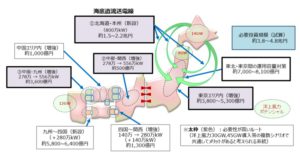(理工学部/建築・環境学部教養学会主催ミニ講演会)
第61回理科系学生のための公開英語講演会
War of Current:
DC vs. AC; Edison vs. Tesla; GE vs. WEC
電流戦争
講師: 理工学部、電気・電子コース
植原 弘明
During the early years of electricity in the United States in the late 1980s, the main current distributed to households and used there was direct electric current (DC), use of which Thomas Edison strongly pressed forward with. While DC had an advantage of being easy to deal with (, as indicated by the fact that it runs constantly in one direction), it had a problem of being difficult to change into different voltages. As opposed to Thomas Edison, Nikola Tesla tried to resolve this problem by adopting alternating current (AC) as the electricity for distribution. Significantly, Tesla developed a transformer for changing the voltage of electricity. After a fierce battle, the AC camp finally prevailed over the DC camp, as is represented by the fact that currently the rate of AC transported in the world is higher than that of DC.
However, contrary to the rough sketch of the so-called “war of the currents” above, if we now look around ourselves and check to see what electric devices we use every day, we soon notice the need to reconsider that conclusion and wonder if AC really prevailed over DC; after all, electric appliances or even means for transportation that we use every day such as iPhones, PCs, Play stations, solar cells, LED displays, LED printers, electric vehicles, or Keikyu lines all operate on DC power. For that matter, systems for transporting electricity are also universally shifting toward High Voltage Direct Current transmission systems especially for long distance transmission.
On November 16th, 2023, the 61st session of the English Lecture Meeting for Science Major Students was held under the sponsorship of the Academic Society of Faculty of Liberal Arts, inviting Doctor Hiroaki Uehara of the Department of Science and Technology to give a lecture to the audience of science major students, which was the 8th lecture for this event given by the lecturer with the same title.
Professor Uehara is a leading scholar and an expert in the field of science known as electrical engineering「電気工学」.
In this lecture, the lecturer elaborated on such topics as: types of electricity we use in our household; merits and demerits of DC and AC; the reason why we need High Voltage Transmission; the reason why interchanging electrical energy was not possible between Eastern Japan and Western Japan at the time of Great East Japan Earthquake, Higashi-Nihon Dai-Shinnsai that occurred in March 11, 2011; problems we have in our Power Accommodating System; current issues for energy production and its use in the world, as well as in Japan; and finally the question whether AC was the winner or not.
In the subsequent question period, questions including the following were raised by the audience, to each of which Professor Uehara gave detailed answers:
Q1: Currently in Japan, we often hear the news about the shortage of electricity, especially in the Kanto district. Would it be possible to solve this problem if the DC electricity were used in the provinces and the AC electricity in urban areas, thereby helping to avoid excessive consumption of each current?
現在の日本では東京などの関東地方の電力不足が問題になっていますが、地方を直流、都心を交流の電力にして各々の使用量を緩和すれば解決されるでしょうか?
A1: This is a rather complicated problem to solve. You proposed that direct current and alternating current be supplied to different areas of this country, as it were, in the division of labor. In our country, the whole system of transmission of electricity is already established as an AC transmission system; only in some parts of the country, is DC transmission adopted as in Hokkaido-Honsyuu, Awaji Island-Honsyuu, or Awaji Island-Shikoku. In contrast, as a global trend, more and more countries, e.g., European countries and China, are shifting their transmission system from the AC system to the DC system. Conscious of this trend, the Ministry of Economy, Trade and Industry (METI) is considering shifting our energy transmission system from the current AC-dominant one to the DC-dominant one as a promising future option for this country. They are seriously discussing this issue because in the aftermath of the Great East Japan Earthquake in 2011, we realized that the shortage of electrical energy was an actual problem that could happen in this country, especially when we found that it was far from easy to supply the electricity stored in Western Japan to Eastern Japan for the use in the disaster-stricken areas in the Tohoku region. Although we tend to become accustomed to the convenience in our daily lives and tend to forget this imminent problem, energy conservation will become an urgent issue in the near future. Related also to this problem is the question of how much of renewable energy we can produce hereafter.
※画像は経済産業省より引用
Q2: I thought that because the alternating current periodically reverses the flow of charge, the method of generating electricity must be changed each time the flow reverses. If AC current periodically reverses its direction, how is it generated in a constant manner?
交流電流は周期的に電荷の流れが逆になるため、流れが逆になるたびに発電する方法を変化させなければならないのではないかと思ったのですが、どのようにして発電しているのですか。周期的に方向が逆になる交流電流はどうやって永続的に発電しているのですか。
A2: As shown by the following pictures, both in hydroelectric power generation and in thermal power generation, electrical power is created by converting mechanical energy into electrical energy. For example, in the former case, electricity is generated by rotating a turbine generator or a water wheel generator to produce alternating current. In these methods of generating power, the nature of alternating current that you pointed out, that it changes the direction of its flow periodically is not particularly an obstacle. Incidentally, for solar thermoelectric power generation, the main obstacle is possible shortage of sunlight due to the unpredictability of hours of sunshine. The same holds true of wind power generation because hours of sunlight crucially affect airflow.

